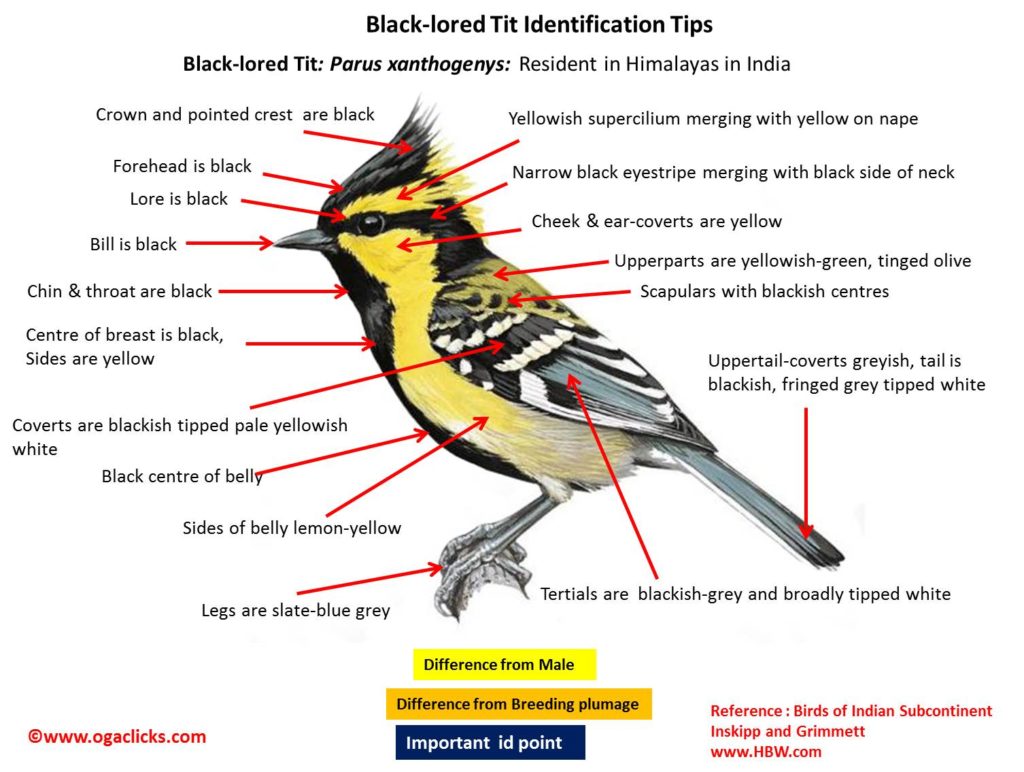Black-lored Tit

Black-lored Tit Parus xanthogenys
Etymology :
- Parus : Latin word for Tit
- Xanthogenys: Greek word xanthos-yellow ; genus- cheek
Vernacular Name :Hindi: Peelaramgangara, Lepcha: Muchetink pho, Guj: Pilichotiliramachackli, Chotiliramachakali, Mar: Pivalaramgangara, Mal: Pacha-marapottan
Distribution in India: Resident of Himalayas in India
Description: Size of 13–14 cm; Wt. of 12·9–19·7 g. It is a medium-sized, crested, black and yellow tit. The male nominate race has black forehead, lores, crown and pointed crest. It has a yellow nape extending upwards onto tips of longest crest feathers. It has a yellowish supercilium flaring behind eye and merging with yellow on nape, broad black eyestripe merging with black side of neck. The upperparts are yellowish-green, tinged olive, scapulars with blackish centers. The uppertail-coverts are greyish; tail is blackish and fringed grey. All feathers are tipped narrowly white, outer web of outermost rectrix is white. The upperwing-coverts are blackish, median and greater coverts broadly tipped pale yellowish, the alula broadly tipped yellowish-white; flight-feathers are blackish-grey, the tertials fringed yellowish-white and broadly tipped white, secondaries and inner primaries finely fringed greyish and tipped white, outer primaries broadly white at base . The cheek, ear-coverts and upper neck side are yellow. The chin, throat and side of neck to center of breast and center of belly isblack. It is slightly glossed blue on throat and breast, sides of breast and belly are lemon-yellow, flanks the same or washed olive and undertail-coverts are dark grey and tipped whitish. The axillaries and underwing-coverts are whitish. In worn plumage, upperparts duller, more grey-green, and dark centers of scapulars larger, the cheeks and nuchal patch paler, fringes of flight-feathers reduced, and tips of rectrices abraded; iris is dark brown; bill is black: legs are slaty blue-grey. The female is like the male, but has slightly duller crown and slightly shorter crest, and face and nuchal patch a shade paler yellow.
Habitat: It is found in open submontane and montane subtropical forests or evergreen forest; also in mixed bamboo jungle and secondary forest, scrub and scattered trees, ban oak jungle and wooded edges of cultivation, like coffee plantations, cardamom sholas, and occasionally gardens. It breeds from 850–3000 m and in non-breeding season, comes down to 915 m.
Food habits: It eats small invertebrates and larvae, spiders, ants and cockroaches. It also eats fruits, flower buds and nectar. It is found usually in pairs or in small groups.In non-breeding season joins mixed-species foraging flocks with small Babblers, Flycatchers, Minivets, White-eyes, Leaf-Warblers and Nuthatches. It actively and acrobatically forages in trees, usually at middle to upper canopy level; rarely descends to the undergrowth. It clings upside-down on leaves and slender twigs; occasionally pursues insects, especially flying ants, in flight.
Breeding habits: They breed in Mar–Jun in Himalayas. The nest is built by both sexes. The nest is made up of mostly of moss, lichens, plant fibers, wool and animal hair or fur, in natural hole or cavity in tree, occasionally in disused hole of Woodpecker or Barbet, or in hole excavated by birds themselves in rotting stump or branch. They lay a clutchof 4–5 eggs. Both the parents feed and care for nestlings.